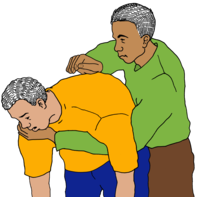Hesperian Health Guides
COVID-19: Breathing
Sickness can cause congestion in the lungs, lessening the amount of air and oxygen the lungs can take in or the amount of used air the lungs can expel. Instead of taking deep breaths, a person may breathe fast, shallow breaths, trying to get enough air. If shallow breathing becomes a habit, it can harm your health. These exercises that make you breathe deeply can help open the airways in the lungs.
COVID-19 can make breathing difficult or even painful. Moving around and exercising your lungs can make breathing easier and help you get the air you need. And if you start exercising before you get sick, your breathing may be less affected.
Breathing exercises
Do these breathing exercises for 10 or 15 minutes, 2 times a day. The more you practice, the easier they will be to do, and the better they will make you feel. For all exercises, breathe in through your nose. It cleans, warms and moistens the air coming in.
Feel your breathing
- Sit or lie down in a comfortable position. Put your hands on the bottom of your ribcage, where you can feel your ribs and your belly.
- Breathe in through your nose and feel your entire lungs fill with air. Breathe out through your nose or mouth. Feel how your belly and ribs rise as you breathe in, and fall as you breathe out.
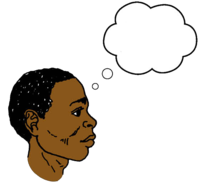
Pursed lips breathing
This exercise will help you slow down your breathing.
- Breathe in through your nose and fill your lungs, counting as you do.
- Pressing your lips together, breathe out through a small space between your lips, as large as if you were whistling. Count and make the breathing out last longer than the breathing in.
Small breath holds
A good way to strengthen your lungs and control your breathing is to delay breathing in. This may also help stop an asthma attack or a panic attack.
- Take a normal deep breath through your nose. Then breathe out through your nose and pinch it closed. Count slowly to 5 before letting go and breathing in again.
- Then breathe normally for 2 or 3 breaths.
- Then repeat: breathe out, hold your nose, and count to 5 before letting go, breathing in, and continuing the exercise.
Deep breathing
Deep breathing opens the chest. Breathe slowly and gently when breathing deeply. Deep breathing can help loosen congestion in your lungs. Do this 3 to 5 times:
- Take a slow, deep breath through your nose.
- Hold your breath for 2 or 3 seconds before gently breathing out, like a sigh.
Huffing
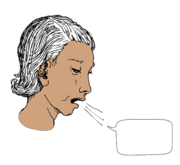
Huffing is breathing out forcefully through your mouth, without coughing. This exercise helps move congestion out of the lungs.
- Breathe in normally and then push your breath out quickly and forcefully through your mouth until your lungs feel empty. Your breath going out will make a “huff” sound.
- Repeat this several times, huffing the air out through your mouth opened wide.
If you hear a crackling noise when you huff, coughing may help you clear the congestion. Be careful not to cough too much.
| Ask someone who knows yoga, Qi Gong, or another slow movement and breathing practice to teach you some movements that you can do every day. | 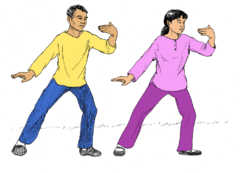 |
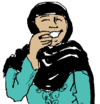 | Laughing and singing are both good for breathing. They exercise your breathing, help clear the air out of your lungs, and best of all, make you feel good. |



